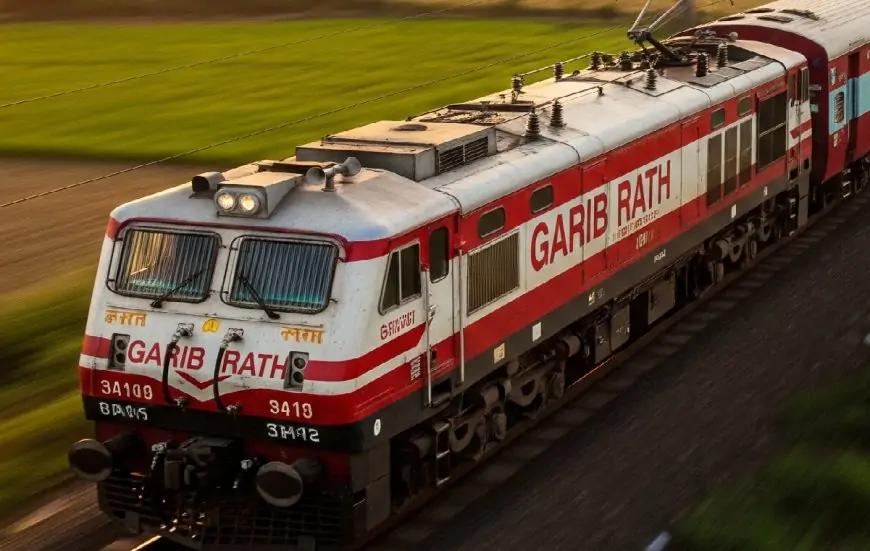Garib Rath Train Ticket Price: Affordable Travel & Services for All
Byline: Staff Reporter | June 2025: India’s railway network is often referred to as the lifeline of the nation, connecting distant towns and bustling metropolises through a vast web of routes. Among the many train services operated by Indian Railways, Garib Rath Express stands out for its unique mission — providing affordable, air-conditioned travel to the common people.

Launched in 2005, the Garib Rath, which translates to "Poor Man's Chariot," was designed to cater to passengers who wish to enjoy comfort without burning a hole in their pockets.
As inflation and fuel prices continue to affect transportation costs across the board, many travelers are looking closely at the fare structures of trains like the Garib Rath. Let’s take a closer look at how Garib Rath tickets are priced, who benefits from the service, and why it remains a preferred mode of transport for budget-conscious passengers.
What Makes Garib Rath Different?
Garib Rath trains are fully air-conditioned, much like premium trains such as Rajdhani or Duronto. However, what sets them apart is the significant reduction in ticket fares. While most AC trains come with higher price tags, Garib Rath maintains affordability by offering lower fares, denser seating arrangements, and minimal frills.
The trains operate with 3-tier AC coaches primarily, and some services also include AC Chair Cars. To maximize the number of passengers per coach, the space between berths is slightly reduced, and amenities such as free meals or bedding are generally not included in the base fare.
Ticket Prices: Affordable Yet Strategic
The fare for Garib Rath trains is approximately 65–70% of the cost of a regular 3-tier AC fare in other trains. This reduced rate is achieved by cutting down on luxury services while retaining the essential comfort of air-conditioned travel.
Here’s a breakdown of typical ticket prices (as of 2025 estimates):
-
Delhi to Mumbai (Approx. 1300 km): Around ₹700 to ₹900 for AC 3-tier.
-
Kolkata to Patna (Approx. 530 km): Around ₹400 to ₹500 for AC 3-tier.
-
Bangalore to Hyderabad (Approx. 650 km): ₹500 to ₹650 for AC 3-tier.
-
Delhi to Jammu Tawi (Approx. 600 km): ₹400 to ₹550 for AC 3-tier.
Please note that prices vary slightly depending on the season, demand, and specific train schedules.
Why the Garib Rath Remains a Passenger Favorite
Despite fewer luxuries, the Garib Rath has a loyal passenger base. Here's why:
-
Affordability: For many, the Garib Rath offers the only practical way to travel long distances in AC comfort without spending excessively.
-
Decent Comfort: Though slightly more crowded than regular AC coaches, the comfort level is still significantly better than non-AC sleeper or general class.
-
Reliability: These trains often operate on busy routes and have relatively high priority in the railway network, leading to fewer delays.
-
Catering to the Middle-Class and Students: Students, working professionals, and middle-income families benefit most from these trains, especially during holiday seasons or exam times.
How the Ticketing System Works
Garib Rath train tickets can be booked like any other train through online portals, railway stations, or authorized agents. Concessions for senior citizens are generally not available, as the prices are already subsidized to an extent.
Unlike premium trains, the Garib Rath does not usually offer Tatkal Quota or Premium Tatkal. The focus remains on serving as many passengers as possible at minimal rates.
The Challenges
While the train is widely appreciated, it’s not without its limitations:
-
Limited Routes: Not all major routes are covered by Garib Rath trains. As of now, only select city pairs have this service.
-
No Free Bedding or Meals: Passengers must carry their own bedding or purchase it separately if available.
-
Congestion: Because of denser seating, the coaches can feel more cramped compared to other AC trains.
Is It Sustainable?
One of the biggest questions railway officials face is whether Garib Rath’s pricing model is economically viable in the long term. Operating air-conditioned trains involves higher electricity and maintenance costs. With ticket prices kept low, the railways must manage these costs smartly, often depending on cross-subsidies from more premium services.
Still, from a social equity perspective, the Garib Rath plays a crucial role. It enables individuals from modest backgrounds to travel with dignity and safety.
Government and Policy Perspectives
Since its introduction, successive governments have debated over the expansion or potential phasing out of Garib Rath trains. Some railway ministers have proposed merging the services with regular express trains, while others have supported extending them to more regions.
In recent years, the emphasis has shifted slightly toward semi-high-speed trains like Vande Bharat Express, which are more modern and faster but come with a higher price tag. However, the need for a low-cost AC travel option remains, especially in Tier-2 and Tier-3 cities.
What the Future Holds
As India aims for modernization of its rail infrastructure, balancing affordability and innovation will be crucial. Garib Rath may see updated coaches, better maintenance, or integration with digital platforms to enhance convenience. There’s also discussion around introducing hybrid models — combining low-cost AC with improved onboard services, without a sharp rise in fares.
For now, Garib Rath continues to fulfill the dream of many Indians: to travel safely, comfortably, and affordably across the vast stretches of the country.
Conclusion
In a country as vast and diverse as India, where millions rely on trains for their daily lives, the importance of inclusive travel options cannot be overstated. Garib Rath trains have carved out a niche by offering air-conditioned travel at prices that are within reach for the average Indian. While challenges remain in terms of expansion and modernization, their impact is undeniable.
As more people look for economical yet comfortable travel options, the Garib Rath remains a symbol of accessible progress — a reminder that even in a fast-paced world, affordability should not come at the cost of dignity or convenience.























